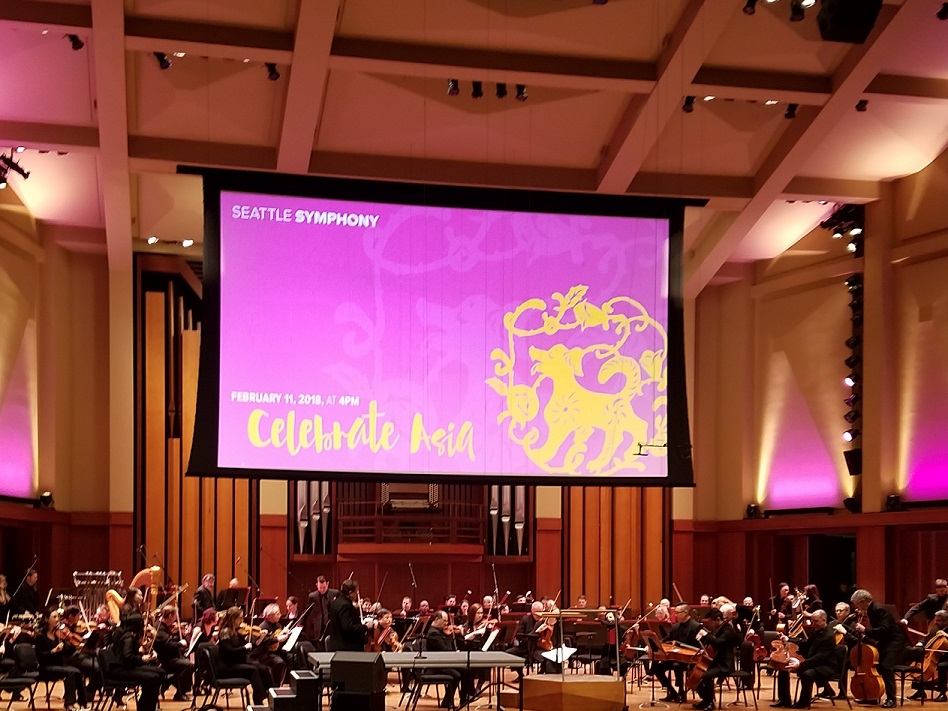By Jessica Kai Curry
NORTHWEST ASIAN WEEKLY

The stage is set as Seattle Symphony members warm up for the main performance (Photo by Jessica Kai Curry)
Community is a two-way street. This concept, expressed by Jerry Lee of the MG2 Foundation, was a predominant theme of Seattle’s 10th annual Celebrate Asia festival, hosted on Feb. 11 by the Seattle Symphony, and sponsored by Lee’s Foundation and the Northwest Asian Weekly, among others. Sharing culture is a two-way street. Celebration is a two-way street.
As the presenters of Celebrate Asia know, in order to create a community, people have to work together. In order to share, there must be a willingness to give and receive.
“Through Celebrate Asia, the Seattle Symphony reaches out to different members of the community and lets them know that they are welcome,” said Seattle Symphony Public Relations Manager Shiva Shafii. “Celebrate Asia is a celebration of the different cultures that make Seattle.”
Most people are aware of the diversity in Seattle, yet not often do different cultures have an opportunity to intermingle. This is the opportunity Celebrate Asia has provided since its inception. On Feb. 11, cultural sharing began even before the doors opened, as guests arrived clad in festive clothing from various countries. Upon entering the lobby, guests were greeted by regional pageant winners. Emcee of the pre- and post-show, Aleksa Manila, is the 40th Miss Gay Seattle. The message was: diversity comes in many forms, and Celebrate Asia welcomes them all.
When asked what they most enjoyed about participating in Celebrate Asia, people like Shub Kaur, director and choreographer of Rhythms of India, described that it gives them “a chance to share our culture with the mainstream.” During the post-show, Kaur’s group encouraged guests to follow along to Bhangra and Bollywood rhythms.
Another aspect of Celebrate Asia performers and the audience enjoyed was the variety of settings. Attendees were first drawn to the lobby stage, where Vietnamese dancers from GDPT Lieu Quan and Chinese dancers from Huayin Performing Arts Group performed a charming collage of traditional and contemporary pieces. Just before the main event, Duoc Su lion dancers sprang directly into the audience, drawing everyone into the auditorium. During the post-show, the percussion of CHIKIRI and the Drums of Taiko summoned everyone back to the lobby, where the performers were arranged on the balcony.
“The audience is feeling the reverberation of the music of the orchestra, but suddenly get into the shower of Taiko drumming,” explained Asako Tateishi, president of the group and also a musician. “That’s exciting!”
It’s a two-way street to combine the East and West so effortlessly, and this was what Celebrate Asia 2018 did. Inside the auditorium, there was a two-hour demonstration of what happens when the best of both worlds are sewn seamlessly together. This was one reason Lindsey and Elizabeth Miller, of Queen Anne, came to the show — to witness whether a violin and an erhu can play the same piece at the same time and do so successfully. The answer was a resounding YES.
“It was moving to me. The whole thing,” said Lindsey Miller, who was on the edge of his seat during the Seattle Symphony’s collaboration with sitar virtuoso, Nishat Khan.
The concert heralded a first, a return, and more than one guest of worldwide repute. The event was the Seattle Symphony debut of director DaYe Lin, music director and chief conductor of the Shenzhen Symphony Orchestra, whose athletic yet expressive style was as impressive as his manifest appreciation for his fellow musicians. This year also marked the return of an honored performer from the first Celebrate Asia: renowned erhu player, Warren Chang, director of the Seattle Chinese Orchestra, whose incredible poise and finesse belied the range of sound and emotion emitting from his instrument.
For the first time, the Seattle Symphony played alongside the Seattle Chinese Orchestra and Chinese Youth Orchestra. The Seattle Symphony sat stage right, arrayed in traditional black, while the Seattle Chinese Orchestra sat stage left, wearing celebratory red. The directors also switched places for a fun experiment, during which Lin directed the Western version and Seattle Symphony director Roger Nelson the Chinese version of Mozart’s “Night Music.”
It was an evening of harmonious and harmonic, juxtaposition. Not only was everyone on a two-way street together, it was a block party, and everyone was going home with the spirit of our community, in all of its diversity, in their dancing feet and humming hearts.
Jessica can be reached at info@nwasianweekly.com.



